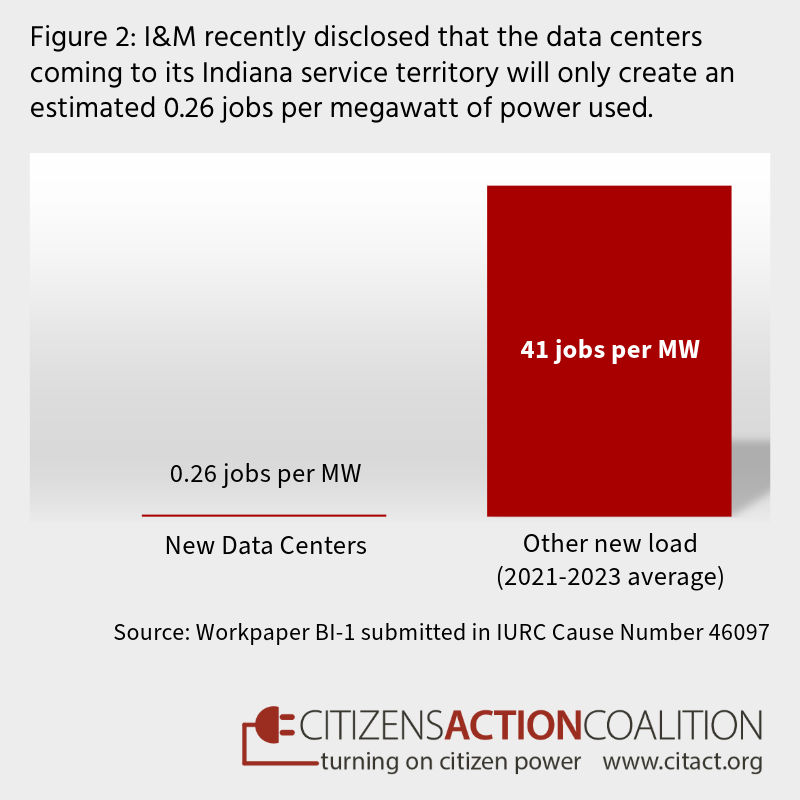AI Data Center Build Out Creates Unprecedented Risk to Hoosiers
CAC calls on Indiana state lawmakers to end the subsidies, increase transparency, and protect Hoosier electric bills from the impacts of AI data centers.
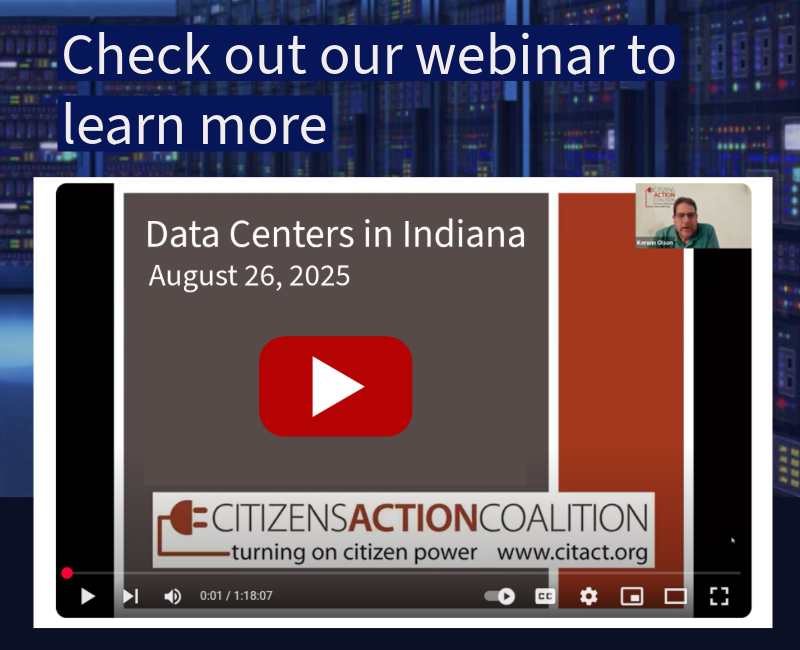
![]() Large AI data centers are coming to communities across Indiana, and many of them are hyperscaler data centers. Larger than traditional data centers and increasingly used to power artificial intelligence (AI), these giant, windowless warehouses are some of the most energy intensive facilities in the world and use significant amounts of water.
Large AI data centers are coming to communities across Indiana, and many of them are hyperscaler data centers. Larger than traditional data centers and increasingly used to power artificial intelligence (AI), these giant, windowless warehouses are some of the most energy intensive facilities in the world and use significant amounts of water.
Data centers are essentially warehouses for computers and servers. They house many computer systems and equipment like servers to store, manage, and process large amounts of data. They are the physical locations of the “cloud.” Up until now, the types of applications that have relied on data centers have been things like streaming Netlix and Spotify, using Google Docs or Microsoft 365, scrolling social media, etc.
However, the AI data centers coming to communities in Indiana are a different beast. These are typically massive hyperscaler data centers being built by companies like Amazon, Google, Meta, and Microsoft, primarily because they want to push the use of AI.
Where Are AI Data Centers Being Proposed?
Click here for the spreadsheet with the data behind this map.
In Indiana, AI data centers have already been announced or are in the planning stage across the state. The largest is the Amazon data center campus coming to New Carlisle, but Microsoft, Google, and Meta have also announced AI data centers.
Many more AI data centers are considering locating in Indiana, with I&M, NIPSCO, and AES Indiana each indicating that they will need enormous amounts of power to serve these prospective data centers.
The LEAP District industrial park boondoggle, which has already been heavily subsidized by Indiana taxpayers, has also been identified as the potential location for a future AI data center.
Rapid and Unprecedented Increase in Energy Demand
 Large data centers are some of the most energy-intensive facilities in the world.
Large data centers are some of the most energy-intensive facilities in the world.
Even in the early stages of Indiana’s experience with AI data centers, these massive facilities are expected to cause a rapid and unprecedented increase in energy demand. Although utilities regularly plan for the future through the Integrated Resource Plan process, the mind boggling amounts of energy large data centers require are completely upending utilities' energy plans.
For example, I&M is forecasting that just a handful of AI data centers coming to Northern Indiana will use more electricity by 2030 than all 6.8 million Hoosiers use in their homes today (see Figure 1).
I&M is also forecasting that a handful of new AI data centers, such as the Amazon and Google data center campuses announced this year, will lead to a tripling of I&M’s electric sales by 2030, with these facilities collectively using 6.7 times more electricity than all of I&M’s residential customers use today.
A single 1,000 MW AI data center will use 52% more electricity than all of I&M’s 420,000 residential customers combined used in 2023.
Indiana is no stranger to large industrial energy users, but the intense energy needs of AI data centers paired with their rapid development presents a new challenge for Indiana utilities and advocates.
Risks for Hoosier utility bills and our environment
-
Skyrocketing Utility Bills
It will cost billions to meet the infrastructure needs of AI data centers, which could lead to skyrocketing energy costs for Hoosiers. People across Indiana are already struggling to afford utility service, especially as 3 out of Indiana’s 5 large electric utilities filed for huge rate hikes in 2024 (CenterPoint, Duke, and NIPSCO). In addition, if data centers close early, ratepayers could be stuck with massive increases to pick up the tab.
-
Air and Climate Pollution
Indiana is already heavily reliant on fossil fuels to produce electricity, and energy guzzling AI data centers could make matters significantly worse. The enormous energy consumption of AI data centers can lead to staggering amounts of additional air and climate pollution. Utilities across the state are planning large expansions of natural gas power plants specifically to serve data centers, which generate large amounts of carbon dioxide and methane pollution that contribute to the climate crisis.
 The coal industry is using the rising power needs of AI data centers to heavily lobby Indiana lawmakers to force expensive and dirty coal plants to stay open longer to meet their massive energy needs. This would jeopardize Indiana’s progress towards better air quality while creating even more coal ash that is already sitting next to our major rivers, leaching into our groundwater and costs millions to clean up, even when utilities clean it up poorly.
The coal industry is using the rising power needs of AI data centers to heavily lobby Indiana lawmakers to force expensive and dirty coal plants to stay open longer to meet their massive energy needs. This would jeopardize Indiana’s progress towards better air quality while creating even more coal ash that is already sitting next to our major rivers, leaching into our groundwater and costs millions to clean up, even when utilities clean it up poorly. AI data centers also usually have on-site backup generators. For example, the planned Google data center coming to Fort Wayne has 36 diesel backup generators, each with a 6,000 gallon diesel storage tank. Diesel generators generate large quantities of air pollution including particulate matter, nitrogen oxides, benzene, and formaldehyde. This pollution increases the risk of respiratory disease, cardiovascular disease, cancer, and neurological disorders.
-
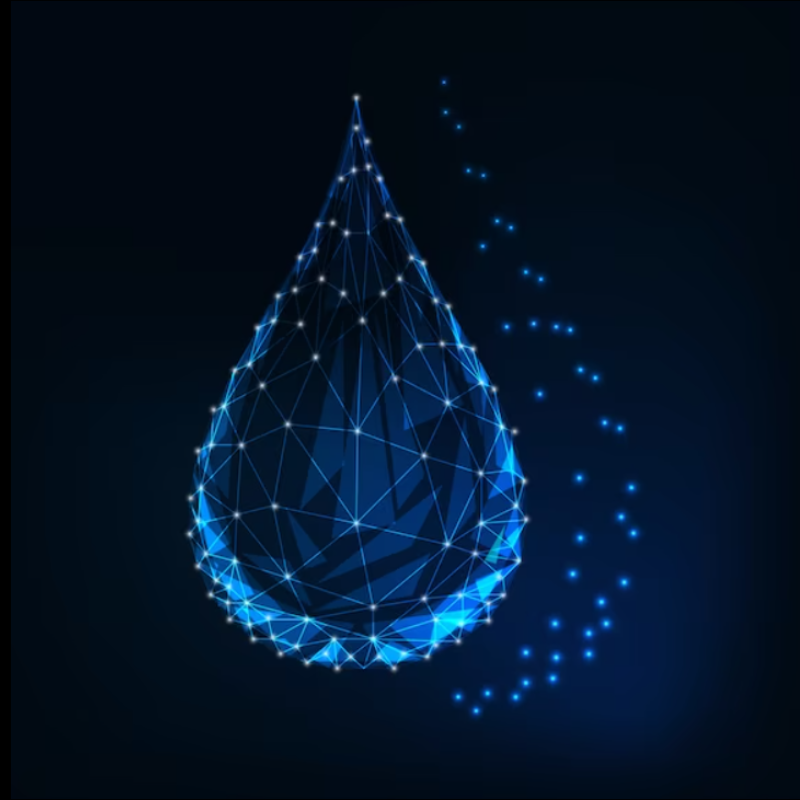 Intense Water Consumption
Intense Water ConsumptionAI data centers use enormous amounts of water, primarily for the evaporative cooling of computers, which generate intense waste heat when they operate (just like your computer might feel hot to the touch when it is running too many programs). AI requires intense amounts of processing, and the more processing done at the data centers, the more heat they generate, the more water they need to cool everything down.
A single AI data center can use anywhere from 1 to 5 million gallons of water per day, as much water as a town of 10,000 to 50,000 people. The Amazon data center and the General Motors Battery Plant developments in New Carlisle have been granted permission for combined use up to 24 million gallons per day from the Kankakee aquifer.
Indiana lacks an integrated approach to managing our water resources - especially for large scale development, as shown by the controversial LEAP boondoggle. This creates big concerns about how water will be allocated to meet the needs of AI data center facilities in addition to other economic development projects, agriculture, and Hoosier households.
-
Noise Pollution
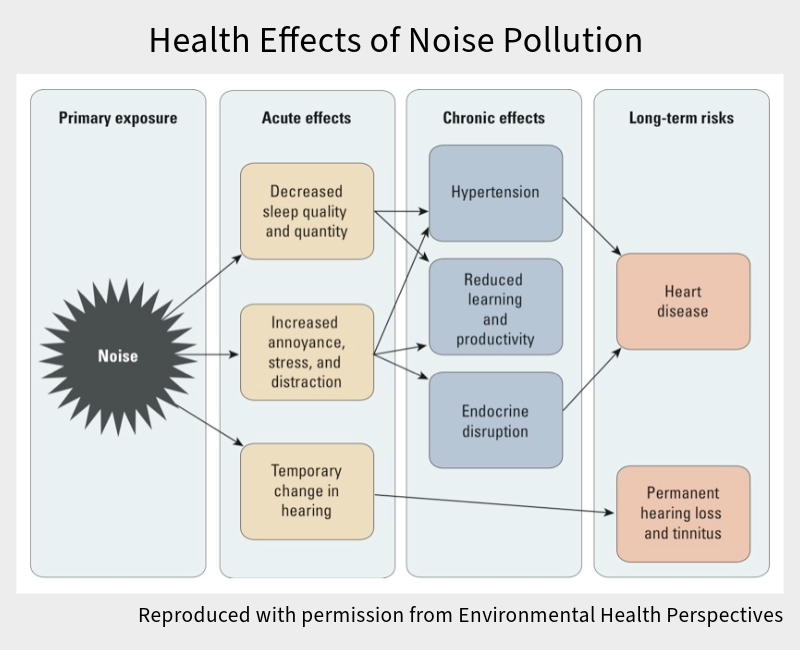 Equipment located at AI data centers, such as servers, HVAC systems, backup generators, fans, and exhaust tubes, can cause noise pollution 24/7, with some data center neighbors measuring noise pollution at 65 decibels into the night.
Equipment located at AI data centers, such as servers, HVAC systems, backup generators, fans, and exhaust tubes, can cause noise pollution 24/7, with some data center neighbors measuring noise pollution at 65 decibels into the night. According to the Boston University School of Public Health, "At only 65 decibels—about as loud as a car going by for someone standing on the side of the road - research has shown that people begin experiencing increased risk of hypertension and heart attack."
Big Tech Resists Transparency
CAC is no stranger to standing up to powerful monopoly interests. But even the smallest of the four big AI data center companies, Meta, has a market value that is about 10 times larger than that of every Indiana investor-owned electric utility’s parent company combined.
The companies building AI data centers are among the wealthiest entities in human history. These entities have gotten big and powerful by creating monopolies and using unfair practices that are now the subject of numerous federal lawsuits and investigations.
Large AI data centers are extremely secretive and fight attempts for even limited transparency of their operations. Amazon, Google, and Microsoft have refused to answer CAC’s questions about their water usage, the amount of state and local subsidies received, and other impacts to neighboring communities.
Often, AI data centers use shell companies and secret project code names to keep communities in the dark about their plans to locate a new AI data center there until after they have extracted local approvals from local government officials who are forced to sign non-disclosure agreements.
Campaign Tools
Take Action Please use this form to email your Indiana state legislators, Gov. Braun, and Lt. Gov. Beckwith, and tell them to protect Hoosiers from the impacts of AI data centers! Help us fight for Hoosiers! What you can do at the local level Ask your city and/or county council members to oppose AI data centers. Attend local government meetings discussing new mysterious “economic development” projects, which could be AI data centers in disguise. Speak out against them. Check out our January 2025 webinar to learn more about The Hidden Costs of Data Centers: I&M Settlement Creates Promising Framework for Data Centers CAC helped to negotiate a legal settlement with I&M, tech companies, and the Office of Utility Consumer Counselor (OUCC) in Cause Number 46097 before the Indiana Utility Regulatory Commission. It creates a promising framework to prevent Hoosier utility bills from skyrocketing due to AI data center infrastructure costs. The following settlement terms offer critical consumer protections that we will work to see extended to all Hoosiers: Long-Term Commitment: requires AI data centers to commit to sticking around for at least 12 years, plus an initial period of up to 5 years when they are ramping up their electricity needs. This provides assurance that these customers are making long-term commitments to paying back the costs of the investments made to serve them. Exit Fee: this requires AI data centers to pay a large fee if they decide to leave Indiana earlier than expected. This is important because utilities will invest billions of dollars in infrastructure to serve AI data centers. If AI data centers close early, exit fees will be used to offset the data center’s share of the infrastructure costs that have not yet been paid back through electric rates, helping to protect other customers from being forced to pick up the tab. With the I&M settlement, a 1,000 megawatt data center would pay an exit fee of more than $1 billion if they close five or more years early. Minimum Bill: this requires AI data centers to pay the utility a set amount every month even if they don’t use as much electricity as anticipated. This will ensure that AI data centers are helping to pay back the big costs associated with making sure there are enough power plants ready to serve them anytime they need. Without this provision, there is concern that an AI data center could end up using much less power in some months than they are currently expecting, which could result in utilities trying to force residential customers to pick up those costs. Collateral Requirements: mean that I&M will be making sure the AI data center companies are financially healthy and capable of paying them back. Reporting Requirements: will create more transparency about AI data centers. I&M will issue semi-annual reports detailing the investments it makes to serve large AI data centers and the amount of electricity they use. In addition to these terms, CAC also helped to negotiate an agreement in the settlement that the big tech companies will provide $7.5 million for low-income weatherization for customers in I&M's service territory. Risk to Hoosier Taxpayers In 2019, the Indiana General Assembly enacted House Bill 1405, which provides large AI data centers with a full sales tax exemption for up to 50 years, while allowing local governments to also enact property tax exemptions. These subsidies are expected to total in the tens of billions of dollars in lost tax revenue for the State of Indiana over the coming decades. According to I&M, a typical AI data center customer is expected to pay an annual power bill of about $500 million, so the sales tax exemption means that Indiana loses $34.5 million annually or more than $1.7 billion in lost tax revenue per data center over 50 years. (See Andrew Williamson's testimony submitted in July 2024 on behalf of I&M in Cause Number 46097.) Heavy on Resources, Light on Jobs AI data centers create exceptionally few jobs compared to the tremendous amount of power they consume. I&M recently disclosed that the AI data centers coming to its Indiana service territory will only create an estimated 0.26 jobs per megawatt of power used. Other industries that have located or expanded operations in Indiana recently have averaged 41 jobs per megawatt of power used. The build out of hyperscaler AI data centers in Indiana could severely constrain future economic development and job growth in the state. For example, Meta’s new AI data center coming to Clark County plans to use so much power that any significant new economic development would have to locate elsewhere or wait 5 years or more for the necessary electric infrastructure investments to be completed. ![]()
![]()
![]()
![]()
![]()
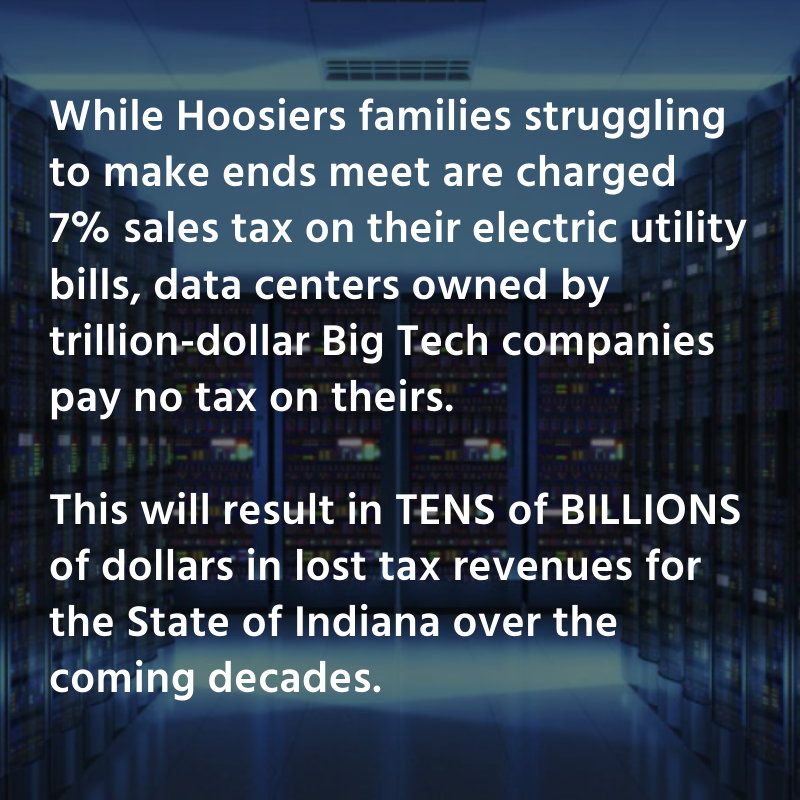
![]()


